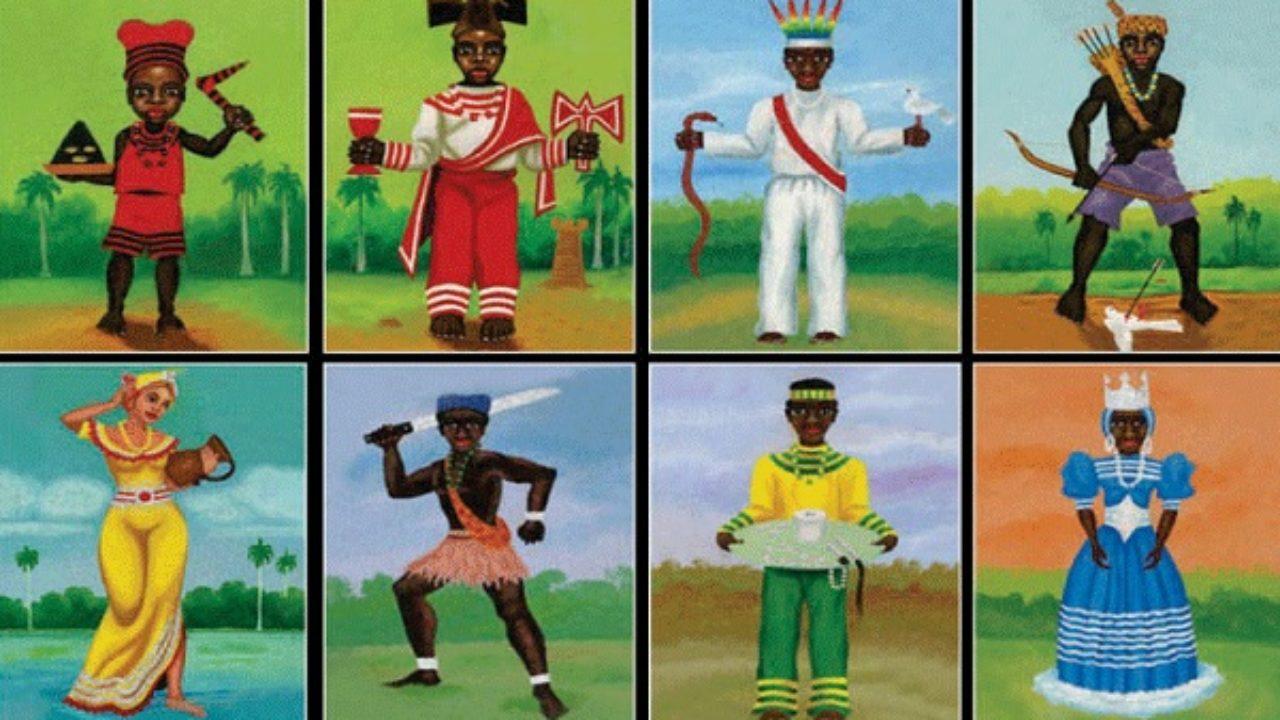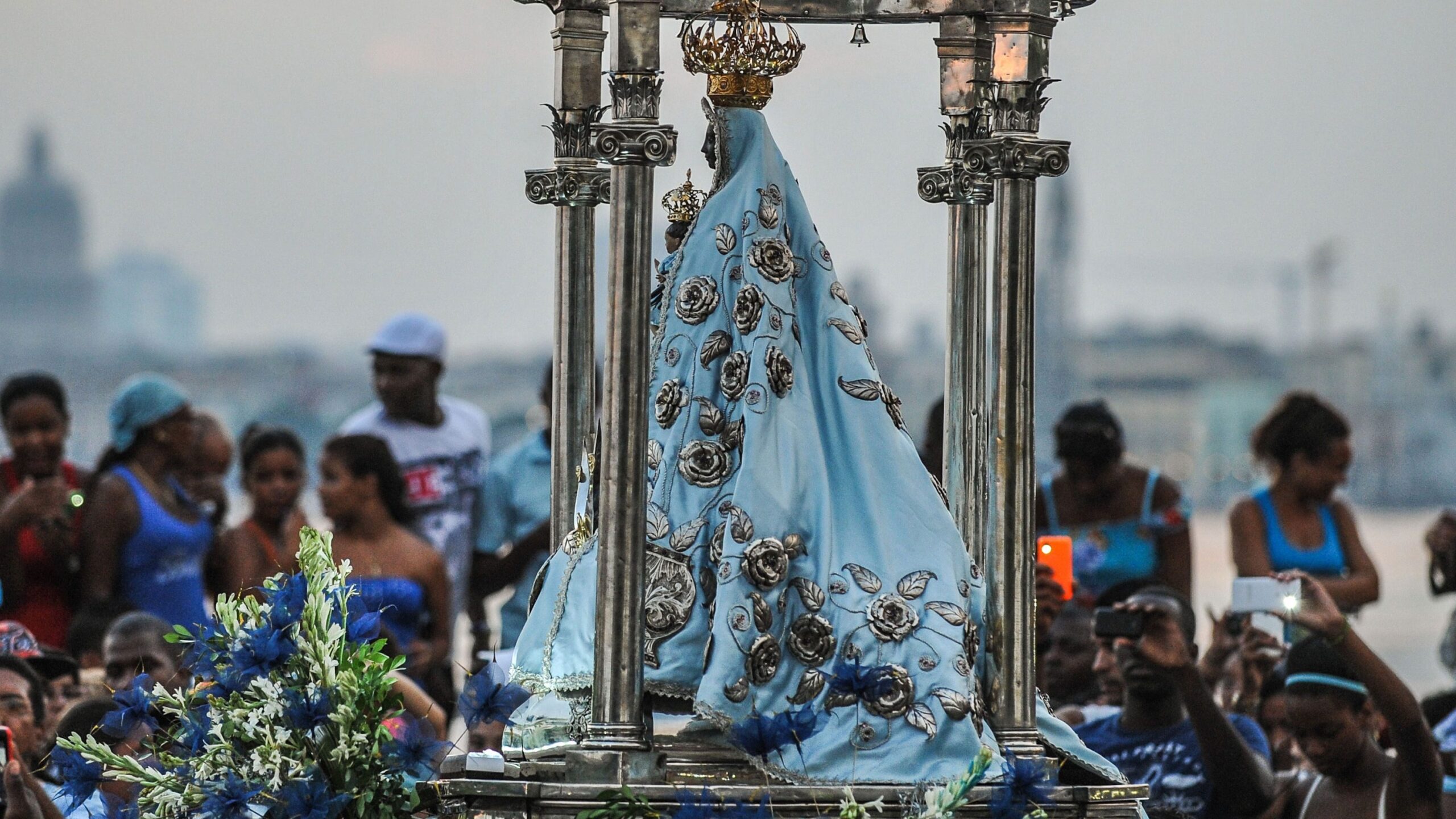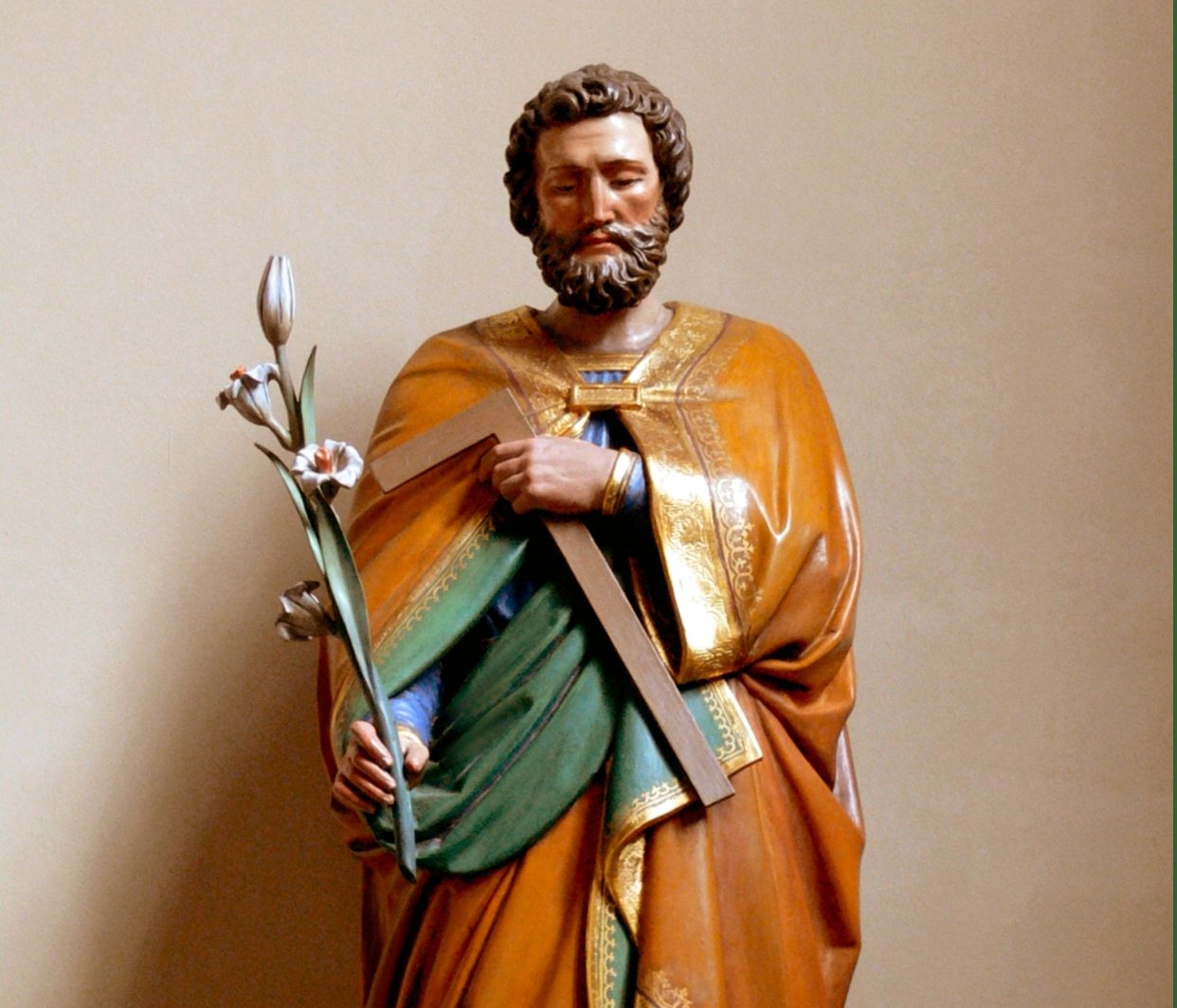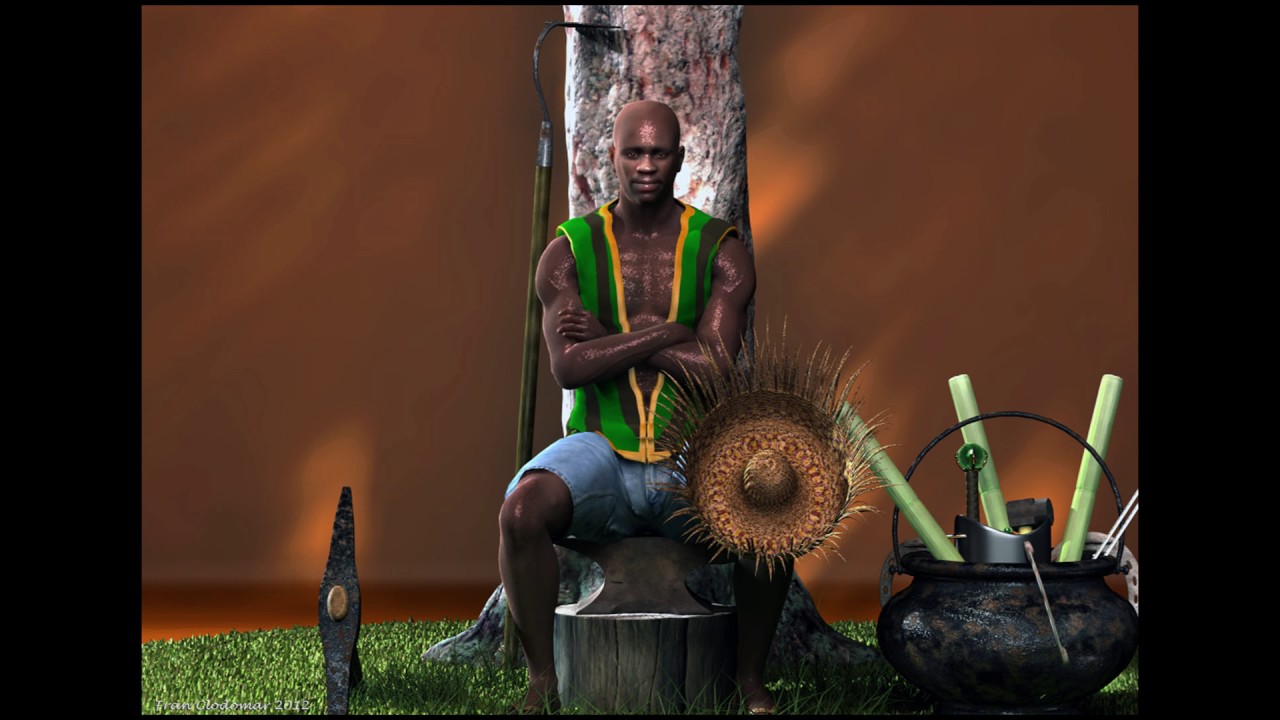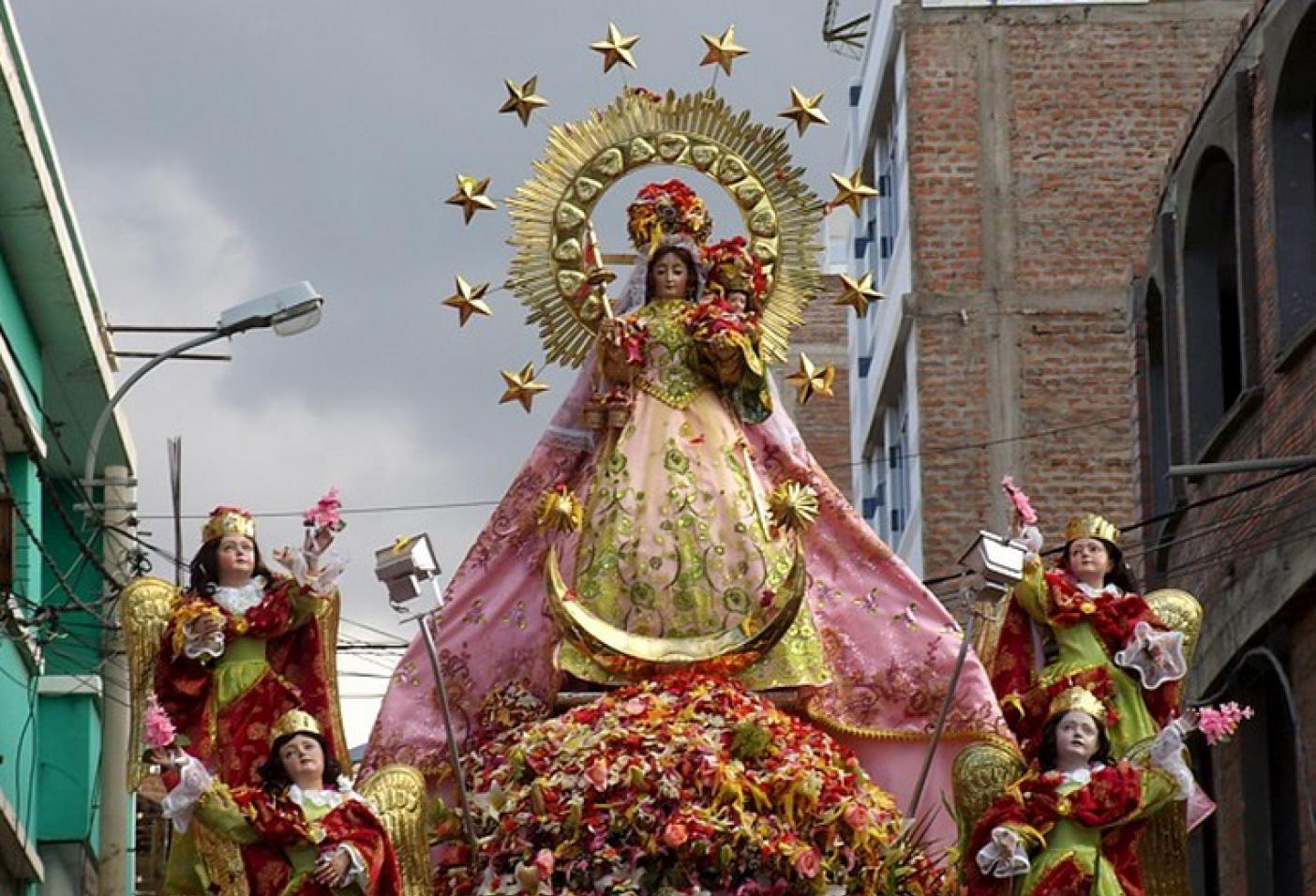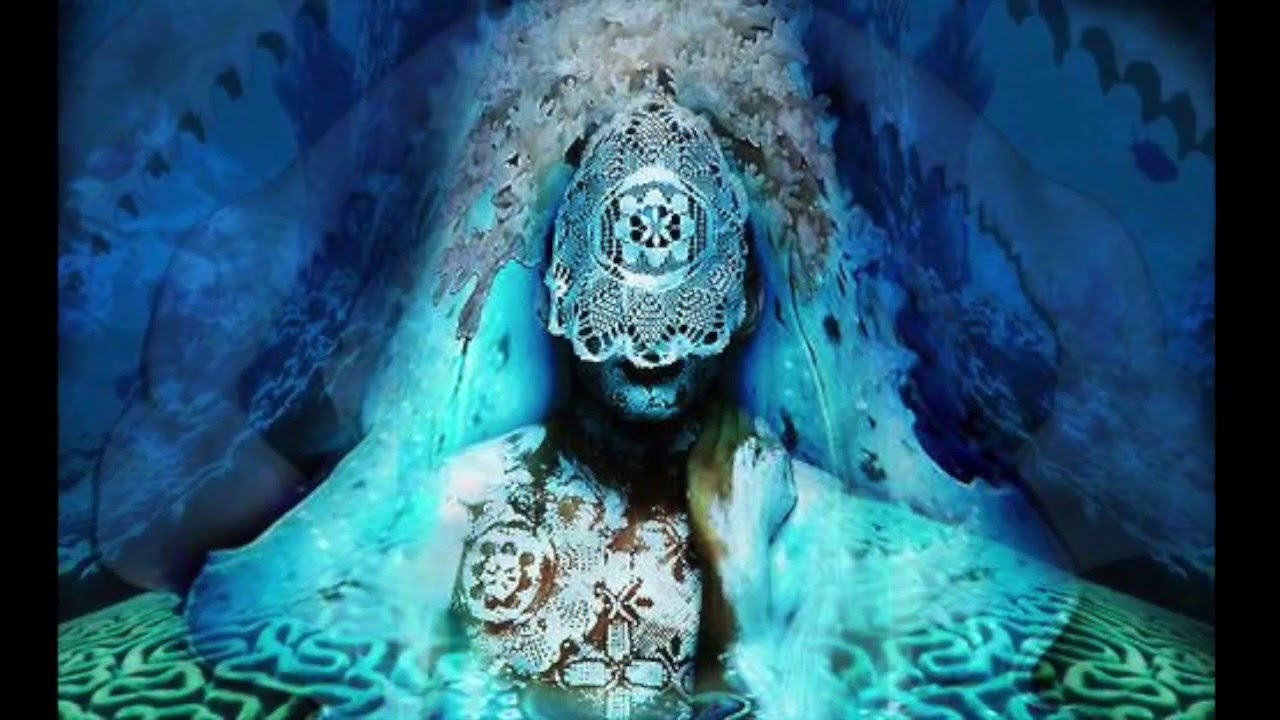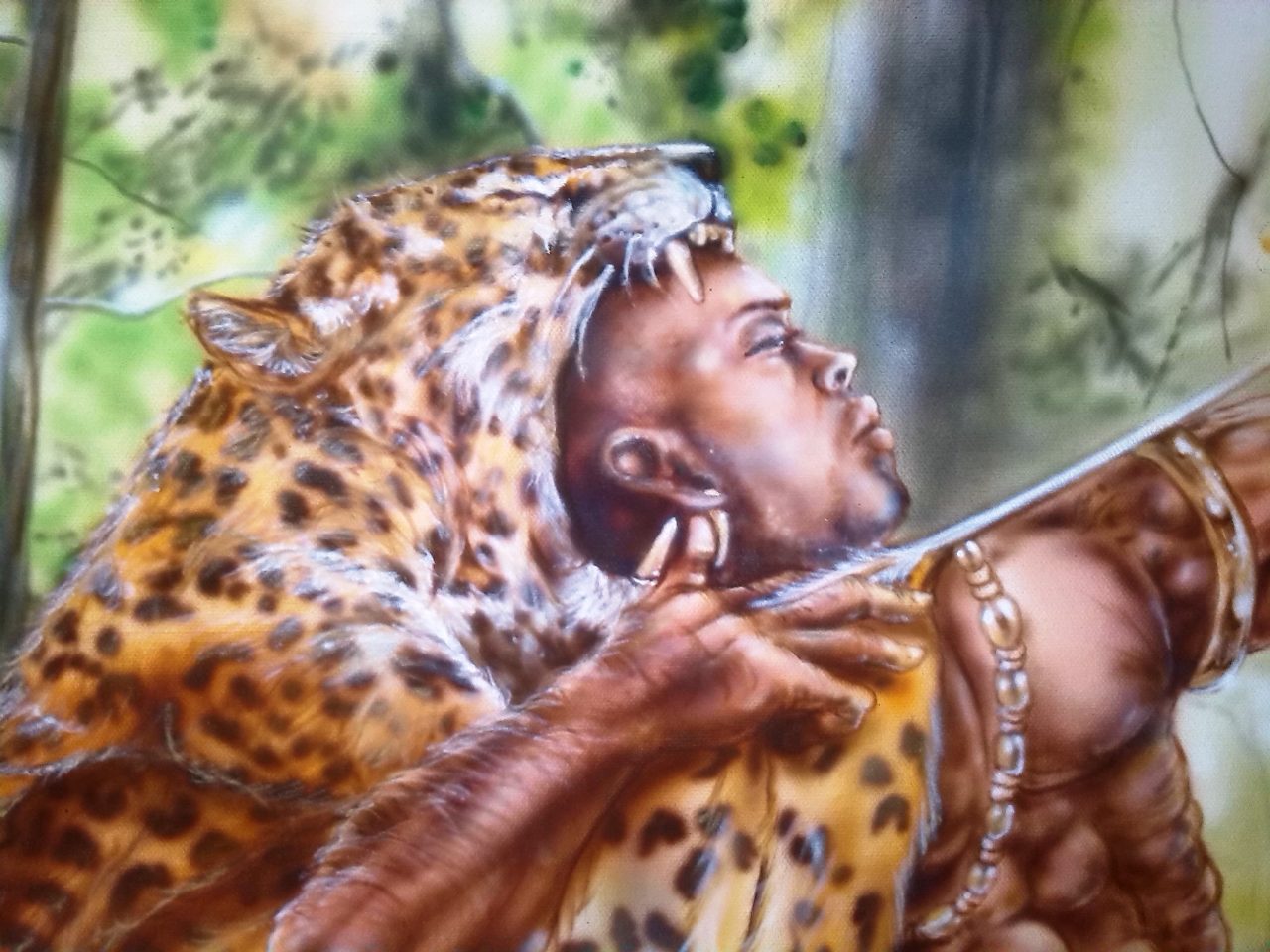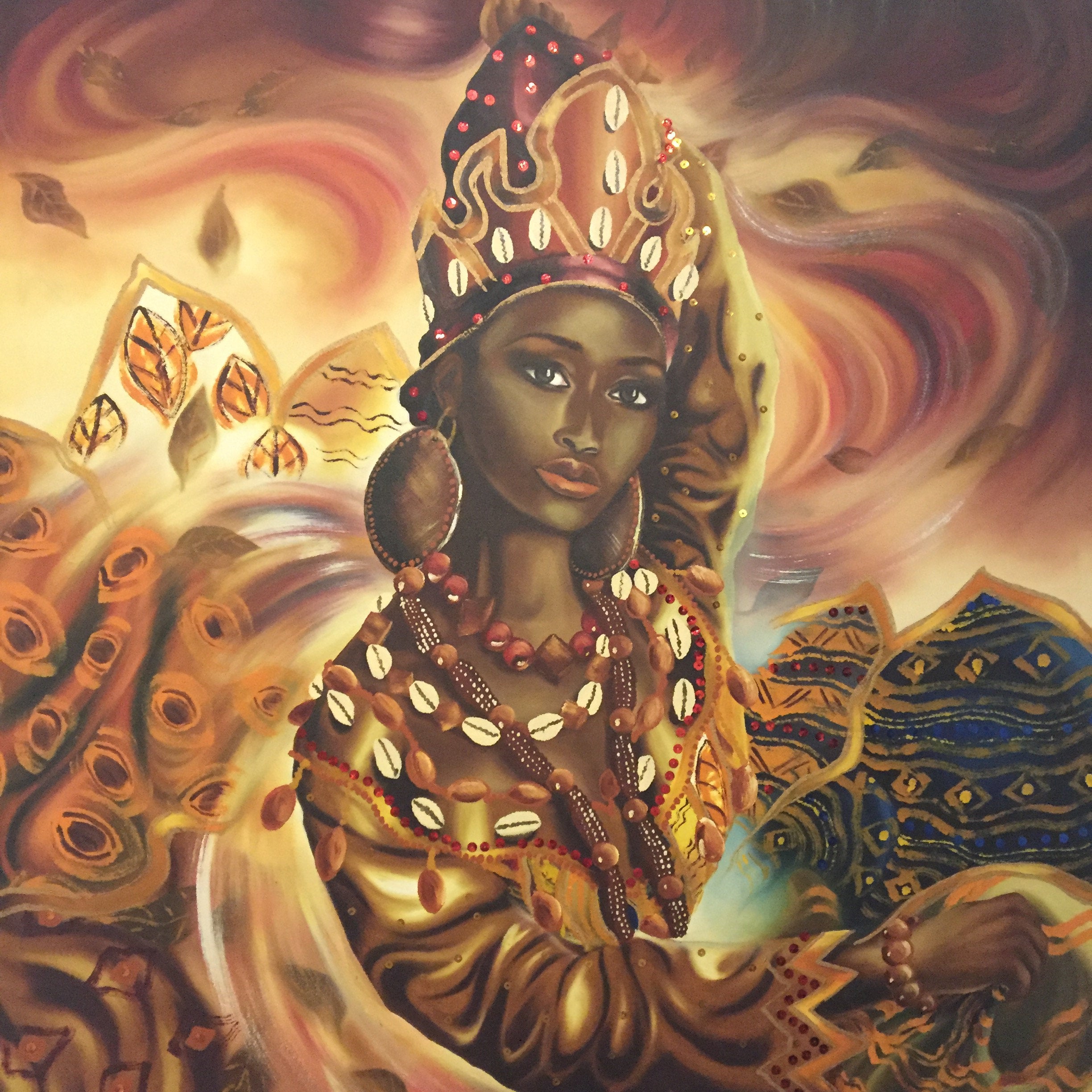Santería is a religious belief that emerged from the fusion of two religions, it is basically the adoration of the saints. Just as the saints serve as emissaries of the creator God in the Catholic religion, the santeros also have a creator god and a large number of minor deities. get to know What are the saints of Santería called?!
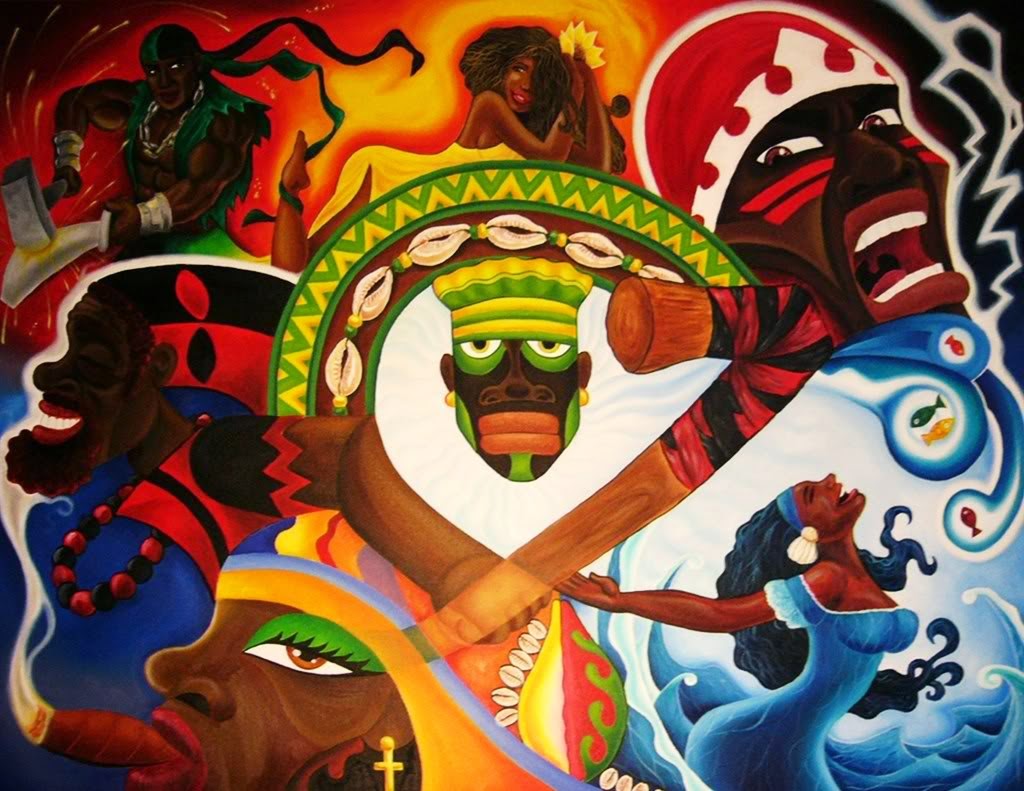
What are the saints of Santería called?
Minor deities, saints or as they are known among santeros, the orishas have the power to govern all aspects of nature and human endeavor, they are messengers of the main god of the Lukumi religion and like the saints of the Catholic religion, you can resort to a specific orisha, depending on those that afflict you.
Why is the Catholic religion usually mentioned in the origins of Santeria? Have you ever wondered why images of Catholic saints are sold in stores dedicated to this religion of African origin? How did the Catholic saints become related to the African pantheon that would become Santeria or Voodoo? What are the saints of Santeria called?
It's a story that goes back to the late XNUMXth century, when large ships brought African prisoner-of-war populations, mainly from the Benin and Yoruba kingdoms in West Africa, to be enslaved here in the Caribbean, destined to work in mines and cane plantations.
With their memories and faith as their only possession they arrived in the new world, now “owned by someone”, who in addition to robbing them of their freedom, also decided that their beliefs were not appropriate. Plantation owners baptized their slaves as Roman Catholics and prevented them from practicing their faith, considered pagan. But, recognizing the similarities between the saints and their ancient gods, the slaves found a way to keep what was left to them.
They simply changed the name of their deities and saints to the names of Catholic saints and continued with their old cult, with their faith in Olodumare, the creator of the universe and the other deities, but what are the saints of Santería called?, Well, there really are a few hundred orishas and later we will meet some of them. The combination of these two religions became known as Voodoo in Haiti and the southern islands and as Santeria in Cuba and the northern islands of Haiti.
Santeria is a decentralized religion without a model of ritual, symbol or doctrine. The rituals and even some of the saints will vary from one temple to another, depending on the spiritual leaders or santeros. The cult takes place in a house of saints and the center of worship in Santería is dance, trance and divination.
The worship of the orishas is pragmatic, depending on the need, you pray to the orisha whose power fits the problem. They dress their altars, using the appropriate colors and symbols for the orisha and the presence of the images of the saints in said space is important.
An important component is the sacrifice or offering that is made to the orisha, since it is the energy that feeds the magical work and each orisha has its preferences for food, smoke and drink. Being very important as a sign of respect to remember the saint's feast day and make a special offering.
Among devotees it is claimed that the gods keep very strict accounts of offerings made and favors granted. Even when everyone is invited to pay their respects to the orishas, it is strongly advised that communication with them be with the utmost respect and care, their carelessness could leave your prayer in oblivion.
Many people see Santería as an encounter or point of reconciliation between the pagan African cult and Catholicism, however, others affirm that this is not the case, that the ancient Yoruba faith remained intact and that this link with the Catholic religion was only a resource to pacify slave owners and rulers.
The truth is that many devotees pray in their hearts to the saint and the deity or only to the deity, the images and representations of the saints of both religions coexist in this belief and are a vital part of the practice of Santeria and Voodoo. Below we present a brief summary of the Yoruba pantheon, so that you know what the saints of Santeria are called and also with which Catholic saint they are linked. Come meet them with us:
Yemayá / Mary, star of the sea
When we take a look at the information about Santeria, the question is what are the saints of Santeria called? In this opportunity to meet Yemayá, the African Mother Goddess, an aspect of the Divine Trinity, who governs the oceans, the moon, women and children, fishermen and sailors, witches and secrets. All life comes from Yemayá the sea and she is a mother who never betrays her children.
She is associated with the Virgin Mary in two of her aspects: Our Lady of the Rule and Mary, Star of the Sea. Although little is known about Mary in the New Testament, early Christians recognized her as Mother and from then on they prayed to her, the they saw in visions and experienced miracles when they invoke her.
Mary is known and worshiped under many invocations or titles and is associated with various deities of the black continent. Yemaya's colors are blue and white, hers day is Saturday and she is prayed fervently for a safe journey across the sea, fertility problems, a healthy pregnancy and also healthy children.
Those who are devoted to her and seek Yemaya's protection usually wear a necklace with blue and glass beads in the following pattern: seven glass beads, seven blue beads, one glass bead and one blue bead, a pattern that it is repeated six times, for a total of seven sequences, about 112 counts. If you wish to ask Yemayá for a blessing or to thank Yemayá, respectfully offer her an assortment of grapes, pineapple, watermelon, and bananas in seashells or shell-shaped dishes at the sea, river, or lake shore.
A circle should be made around that offering with seven coins, a representation of the number of days between the phases of the moon, while looking towards the water and reciting your prayer, tell the Goddess your problems and ask for her intercession.
Obatala / Our Lady of Mercy
Obatalá is another aspect of the Divine Trinity. As Yemayá, he is associated with the Virgin Mary, this time under the invocation of Mercy or Piety. As the firstborn of the gods, Obatala is regal and wise, clearing away negative energies and solving ethical problems.
As Yemayá is the patron of mothers, Obatala is the patron of fathers, he has dominion over all white things, from the bones to the clouds in the sky, that is why the offerings to Obatala must be white foods: white chickens, rice , milk, etc., but avoid alcohol, unlike the other gods, Obatala has no taste for alcohol.
It is important that the offering is placed at the base of a tree. It is also recommended that to cleanse the aura, make a bath in which you have poured a cup of milk, seven white carnations, seven teaspoons of sugar and seven drops of holy water, then light a white candle and immerse yourself in that preparation, while You repeat seven Our Fathers.
Orula/ Saint Francis of Assisi
Also known as Orunmila, he is a very important Orichá and is unique in many ways. First, men and women who are initiated in Regla de Ocha or Santería never have Orula sitting on their head as a guardian angel, since he only goes to the head of the babalawos, the men who have been initiated in Regla de Ifá. .
Ocha and Ifá are parallel traditions in Cuba, although they often work together in the same religious community, each performing specific tasks and playing unique roles. Depending on the tradition of a man's lineage, he may not have to be initiated into Ocha first to proceed to Ifá.
Some men are called directly to Ifá through divination and women can only receive the cofá or ikofá from Orula. Any man can receive Orula's hand, which puts them under the protection of the powerful orisha, but does not fully initiate them in Ifa or make them a Babalawo.
Orula is the diviner teacher and according to the patakis, is the only Orichá who knows the future of everyone on earth and has the power to influence destiny, because when Olodumare was carrying out all creation, Orula or Orúnmila was the only one who existed and who witnessed everything. Specifically, he knows when each human being will die and makes sure that our life does not end before, but when it corresponds and at the right time, according to the destiny we choose for ourselves in heaven.
His devotees say that he knows how we can find happiness, health, tranquility and success, because he was present when we came into the world, he knows the future that awaits us and he can help us avoid mistakes by keeping us on the right path.
Orula gives her message to individuals through divination, with the assistance of a Babalawo and the epoder, a divination chain and the ikines, they also use a wooden divination board covered with husk and a piece of deer horn to write. some odu on the tray.
Chango / Santa Barbara
Chango is the third member of the Divine Trinity, lord of transformations, god of thunder and lightning, his devotees turn to him when they need to strengthen their will. This surprising orisha is related to Santa Bárbara and really causes surprise, because Chango's personality as god of fire is that of a passionate womanizer, while Santa Bárbara was a young chaste.
The connection becomes clear when we discover that Changó is invoked when a person seeks revenge on their enemies and Santa Bárbara is the patron saint of wrongful death, as she suffered death at the hands of her father when she found out she had converted to Christianity.
At the moment her father decapitated her with his sword, he was struck by lightning, lightning being a potent symbol for both the Catholic saint and the god of Santeria. Chango and Santa Bárbara are also prayed for protection in storms. Both images are reconciled when seeking to regain one's own power, both related to power and fire, should preferably be invoked with a candle spell, this would be more advantageous.
Make a ring of prayer beads to use in conjunction with the affirmations, these should be red and white in this pattern: six red, six white, one red and one white, repeat six more times, for a total of ninety eight beads . Say your affirmation once for each bead, no matter how many you write, affirmations should be written as positive statements in the present tense, how you want to see your life.
Going from the dream of plans to reality is will and this is the specialty of Chango and Bárbara. It is important to accommodate the altar with red and white fabrics, symbols of machetes or swords, lightning bolts, towers, a cup and images of Santa Barbara.
Light a red candle beginning on Friday night and say your affirmations using your special prayer beads, repeating this ritual every night for a total of twenty-four. During this time it is very important that you place an offering of dry red wine, apples and bananas at the foot of a tree, without fail.
Eleggua / Saint Anthony of Padua
It was said that when Saint Anthony preached in a river, the fish surfaced so as not to miss a word and that after listening to a sermon of Saint Anthony, people who had not spoken to each other in years became friends again and family members separated. They met.
It is probably this eloquence that unites Saint Anthony with Eleggua, the African Hermes, messenger of all the gods. Eleggua is known as Legba in the Haitian faith and sometimes as Eshu. In Catholicism he is also associated with Santo Niño de Atocha. It is always recommended that Eleggua be invoked before praying to any of the other gods. Say:
Eleggua, remove the barrier for me,
Papa Legba, remove the barrier
so that it can happen
And when I return, I will salute the gods.
Eleggua is often depicted as a large clay or cement head with cowrie shells serving as eyes, nose, and mouth. As the patron of doors, Eleggua's place in the home is by the door to protect the home from any negativity.
If you don't have the image of the orisha you can also string a special necklace to place over the door: three red beads followed by three black beads, repeated until you have a necklace with twenty-one beads and he will protect your home. It is important to pay your respects to him on his day, offer him rum and sweets on Monday, his holy day.
To protect yourself from violence, take a red and black bag with you, in the bag, put coffee beans and a whistle, which must be purified with the four elements and anointed with coconut oil. When difficult favors or miracles are asked of you, light a brown candle before the image of Saint Anthony and repeat this prayer:
Glorious Saint Anthony, the sweetest and most eloquent of saints, you who were always willing to speak for those in trouble and miracles awaited your word to come true
I implore you to obtain for me this special favor: mention what you need. I know that the answer to my prayer may require a miracle, but I know that you are the saint of miracles. Please grant this great favor, Saint Anthony. Amen.
Imagine that your prayers rise above the smoke of the candles to Saint Anthony and let it burn and burn out. Then take a bag with food packets and give this to someone in need as an offering to the saint.
You know the name of the Santeria saints in charge of finding missing things, because the person in charge of this is Eleggua or for Catholics San Antonio. This Saint is also very famous for being the one who finds lost things, so when something goes missing or you cannot find it, say: Dear Saint Anthony, I pray that you bring it back without delay.
Osain / San Jose
When the African slaves glimpsed representations of Saint Joseph, Mary's husband, an older man leaning on a cane, they recognized their god of nature, Osain. Saint Joseph is a powerful ally, it is said that he answers all prayers said from the heart. Saint Joseph is the patron saint of parents, foster parents, carpenters and day laborers, of houses and a happy death.
Osain in Santeria is the god of the forest, all wild plants are under his domain, being the patron of all healers and herbalists. His credo is: The forest has everything the santero needs to preserve his health and defend himself from evil.
Something very important is that you should always remember to ask the forest for permission before removing a stone or a leaf from a tree, as Osain supervises the safety of all the sanctuaries. The protection of the houses is where his domain intersects with San José.
It is said that when a house is being sold and no buyer can be found, a statue of Saint Joseph may be buried, to help bring in a real taker. It is said to be a spell that has worked very well over the years.
When you wish to ask him for a favor, a yellow candle is lit and a pine incense stick is burned before the figure of Saint Joseph, which must be passed through the incense smoke three times and in turn repeat this prayer:
Pine smoke and candle fire
Bring a qualified buyer to my house.
Make the sale quick and fair
Oh dearest Saint Joseph, hear my prayer.
Visualize a “Sold” sign and all your belongings are safely packed in a moving van, you are happy to leave and the people arriving at your former home are happy too.
Bury Saint Joseph facing your house and leave his figure there after you move in as a blessing to the new occupants.
You can invoke Ozain and San José to protect your home, as they are powerful in that regard. By the light of a yellow candle, string a necklace made of one white bead, followed by nine red beads, followed by eight yellow beads. Continue in this manner until you have strung a twenty-eight-inch-long necklace. As you string the beads, pray to Osain:
Osain grows, grows, because all green things grow.
Osain heals, heals, Osain's plants heal.
Osain guards, guards, please Osain, protect us.
Gather mulberry thorns, a piece of ash bark, cedar needles, eucalyptus leaves, and acorns. Any of these plants will do, it's always best to find them wild and humbly ask permission before collecting them. Place these protective herbs in a bag with your necklace and complete this spell with a prayer to Saint Joseph to keep your house safe from theft and calamity:
My loving protector, Saint Joseph, that no one who has turned to you asking for protection and help, has been left alone or without relief. I come before you and humbly implore you to protect this house from all evil. So be it.
It is important that everything is done with a lot of trust and respect, also this saint of Santeria has a certain taste for tobacco, so leave an offering of tobacco at the base of a tree.
Oshun / Our Lady of Charity of El Cobre
It is possible that seeing the images of the deities as beautiful ladies with necklaces and colorful dresses or of strong men with bows and arrows as warriors, causes you a lot of curiosity, but it is that in the Lukumi belief their saints are represented that way, being a fairly extensive pantheon. You may wonder, what are the names of the bold and striking saints of Santeria?
Well, you already know some of them, now we introduce you to Oshun, the golden goddess who is also found in the Catholic religion under the umbrella of the Virgin Mary, in this case, Our Lady of Charity of Copper, patron saint of Cuba. As the goddess of love, Oshun rules over pleasure and sexuality, marriage and the arts, but she also oversees all economic affairs, she is famous for her generosity and this is possibly why she is paired with Our Lady of Charity. of Copper.
As expected of a goddess who governs both love and money, Oshun is very popular among the other orishas and also very spoiled, her character is tolerant, because it takes time to get angry, but once this happens Oshun loses her temper and it is said to be extremely dangerous.
She is often depicted dressed in gold or yellow, her arms encircled with many gold bracelets and her hair pinned up with tortoise-shell combs. Her feast is celebrated on September 8. To attract love into your life, you must choose a special gift for Oshun. If possible, give her a gold piece of jewelry and place it on a plate of honey on a Friday night, light a yellow or gold candle next to it, and think carefully about what you want in a lover, being as specific as possible.
The next morning, wrap the gold piece in a small square of yellow cloth and take the offering to a river, where you will leave Oshun's gift. As she drops it into the water she repeats the prayer to Oshun.
When you return home, write all the traits you want in a lover on a piece of white paper with a pen you have never used before, fold the paper five times, and place it under the yellow candle you used the night before in your meditation.
Light the candle and pray to Oshu, tell him your experiences, why you want this lover, what you can offer a lover and everything you want to say, continue with this prayer while you feel good and when you finish praying, turn off the candle. He repeats this prayer for a total of five days, at the end of which time, burn the paper containing his lover's features in the candle flame and bury the remains of the paper and candle by the door of his house.
Remember something very important, be sure to thank Oshun when your lover materializes, make a very special offering of oranges and honey, remember that she is pampered and flirtatious. She take it to the same river and place it on the bank of the same river where you left the first offering.
Ogun/San Pedro
Perhaps it is because Oggun defends the worker, his holy counterpart in Catholicism is Saint Peter. Oggun is the god of war, belligerent and combative, but he is also a worker and the patron and protector of human effort. Similarly, Saint Peter, while not a warrior, has a reputation for being strong, tough, and is asked for when success and a job are wanted. To apply for a better job, a promotion, or to succeed in a new company, he makes the request for him on a Tuesday.
Build an altar with images of Saint Peter, an iron cauldron in which you have inserted two keys that are the emblems of both saints, and seven pieces of iron, such as nails or other tools. The tablecloths must be black and green.
Make a prayer bead necklace using this pattern: seven green beads, seven black beads, one green bead and one black bead, repeat six times for a total of 112 beads.
Among the offerings to Oggun you should place a glass of rum, some smoked fish and a cigarette. He writes his request on a piece of paper and places it under a green candle, which he will light to initiate a moment of meditation, where he visualizes his goal and holds the prayer beads in his hands.
It is important that you keep that image in your mind while you respectfully ask the orisha to grant it to you, then bury your offering at the end of the ritual, as Oggun is a deity of the earth.
There are hundreds of gods in the Santeria pantheon and perhaps you have no idea what the Santeria saints are called and what their powers are, to discover and possibly connect with them it is important to remind you to maintain respect and follow through. by making a request to them, that means that they must fulfill what you promise them.
If working with the orishas is something that appeals to you and you feel connected to them, you may wish to approach Santeria to learn what the Santeria saints are called and how to honor them, something you can do through one of their spiritual leaders. The closer you get to Santeria and the Orishas, the more you will understand the deeper truths regarding this particular belief.
Ochosi/ San Norbert
Oshosi lives in the forest and is a great hunter and fisherman, he is a great warrior, a magician and a seer, he has impressive shamanic powers and is considered an expert tracker and the most talented archer in the world. He is also known as Ochosi, Oshosi or Oxossi, he is the divine hunter and the incarnation of justice among the orishas in the Yoruba religion and their diaspora in the Americas.
While he can wander in and out of the jungle where others get lost, he doesn't live there, he lives in Obatala's castle as his personal hunter. What are the names of the saints of Santeria that the initiates receive in their ceremony? Well, they are the so-called warriors and they are made up of Oshosi and his close friends, Eleggua and Oggun.
He is an orisha of high moral and ethical standards, therefore, he encourages his devotees to be honest and law-abiding citizens, helping them to hit the mark when striving to achieve goals and to do so with integrity.
He is frequently called upon for issues of injustice, court cases, and legal issues and is considered by many Santeria followers to be the patron saint of police officers, court officials, and those in trouble with the law.
Ochosi is usually depicted as an athletic, slender, dark man dressed in furs, wielding a longbow. He usually resides in an open pottery bowl filled with metal tools, many of which are bows or crossbows and deer antlers and legs, along with 18 loose cowries for diloggun divination through which he can speak. There is only one path of Ochosi, unlike other orishas.
Her beaded necklace is made up of royal blue, honey and coral colored beads, her garments are a deep blue with striking gold trim. Altar offerings for Ochosi include anise liquor, grapes, and pears. Remember that you must never ask him to evade the law or try to circumvent justice.
Oyá Yansá /Virgin of Candelaria
Oyá owns the winds and storms, she comes with unexpected changes in the lives of humans. She guards the gates of the holy field, making sure that the boundaries between life and death are respected.
Do you know what are the names of the saints in Santeria who govern lightning? the orishas owners of lightning are Oyá Yansá and Changó. Yansá is the fiercest of the female Orichás and she fights side by side with Changó in many battles, using two swords and using lightning to strike down her enemies, just like Changó. It is very common for her to wear a mask, because privacy is important to her.
Oyá's army is made up of eguns, spirits of the dead, and uses violent winds to sweep away everything in its path. Oyá's day of the week is Friday, which is the day she distributes the punishment to whoever has disrespected her.
This orishá spends time with Oba and Yewá, female orichás who live inside the cemetery, but Changó is her favorite company. It is said that this orisha is the daughter of Obatalá and Yemú or Yembó and is the sister of Yemayá and Ochún. It is probable that she hears among the devotees that Oyá is called by the name Yansa with some frequency.
She dances with a black iruke, a whip made from a horse's tail, which she usually swings over her head at full speed to represent the wind, accompanied by fast and frantic dance steps, making it look like a whirlwind as she moves.
His eleke or beaded necklace is made of red and dark brown with black or white dots. In the case of other lineages, these use lavender beads with yellow stripes or alternating black and white beads. It syncretizes in the Catholic religion not only with the Virgen de la Candelaria, but also with the Virgen del Carmen and in some parts of Cuba with Santa Teresa de Jesús. In Cuba, his party is normally celebrated on February 2, which is the Candelaria party.
Oyá is really an orisha that inspires fear, but she definitely protects those who fiercely respect her. She brings purification into the lives of her devotees by removing all things that no longer serve her and allowing fresh winds to blow to attract new things.
That is why their faithful children are generally very powerful and strong, when they are happy, they are calm and soft as the breeze, but become violent and domineering when things don't go their way.
They are loyal so they are considered good spouses, the big flaw is that they are jealous. Also, don't expect them to spend a lot of time at home, they tend to hate confinement because they get bored easily, so the daily routine really affects them and they find it monotonous.
Olokun
Olokun or Olóòkun, is an orisha in the Yoruba religion who is credited with the paternity of Aje, the orisha of great wealth and from the bottom of the ocean. Olokun is revered as the ruler of all bodies of water and has authority over other water deities. Olokun is god and goddess of the deep waters of the ocean, giver of life and is represented as a figure with outstretched hands holding in each hand the representation of the two spirits that live inside.
Olokun can be invoked through the sound of a bell and a greeting song like this: Okpe egogo ede gbel Okpe emaba ede gbel Okpe ukuse ede gbel Ede gbel Ede gbel Ede Oba gbel Ede Osa gbe.
It represents the riches of the marine world and is associated with the depths of the sea and health. He is considered a dangerous and temperamental orichá, which is why he was chained in the depths of his kingdom. Generally their colors are blue, white or black. Among the attributes that are associated with Olokun are the sirens, the rudder, the anchors, the shells, etc.
Patakís, secrets of the life of the Orishas
The patakis are many sacred legends of the Lucumí religion, they generally tell what the saints of Santería are called, the history of their origins, the relationships they had, the various roles they played in the creation of the world, of humanity and its development . Devotees say that each patakí has a special message, you just have to know how to find it. There are many legends regarding the orishas, but here are some that you will surely find interesting:
Olofi and Ochosi
According to an ancient patakí, when Ochosi lived on earth as a human, Eleguá gave him a special task: he had to find the whereabouts and capture a rare bird that Orula wanted to give to Olofi. Ochosi was skilled at hunting, so the parcel would not be a big problem, obviously he found the bird and took it to his house to put it in a cage, then he went in search of Orula to give him the good news.
In his absence, his mother returned to the house and saw the captive bird, assuming that it was to cook it, he decided to bring dinner forward, so he killed and plucked the bird, then went to the market to buy some of the condiments that were missing for the stew. .
When the man arrived home he saw that the bird was dead, it goes without saying how upset this caused him, much more because he did not know who had killed it. But he decided that he had to go find another animal quickly so that Orula could give it to Olofin, so he hunted and caught a second bird and gave it to Orula and together, they went to present the gift to Olofin.
Olofin was so happy with the gift that he wanted to reward Ochosi, so he gave him a crown and turned him into an Oricha on the spot. He asked him if he wanted something else and the now orisha answered immediately, that he wanted to shoot an arrow and make it pierce the heart of the one who dared to kill the other bird.
Olofi, who knew everything, understood what Ochosi's words meant, so he questioned him again: Are you sure that this is what you want? Yes, Ochosi said, I want justice and Olofin granted his wish.
Then the orisha released the arrow and immediately his mother screamed, of course his heart had been seriously injured and he died instantly. Ochosi felt despondent and sad when he realized what had happened, but he also knew that he had done himself justice. Olofi was certain at that moment that Ochosi would never hesitate to sanction a bad action if it was within his reach, so he entrusted this new orisha to seek the truth and be attentive to justice in the world.
Elegua saved Olofi
On one occasion Olofi, the third person of the Divinity, was in very delicate health and what was even worse, the cause of his illness was not known. When the orishas found out about the situation, they went to meet him with the intention of healing him, but this time his abilities were not enough, no matter what they did, he did not improve.
Elegua, upon learning of Olofin's poor health, asked his mother to accompany him to see him, because he was sure that he could heal him. Standing before him, Elegua made a concoction and asked Olofin to take it without hesitation. Olofi took it, but it had a very bad taste, so he made a disgusted face, to his surprise from that moment he began to recover and get stronger.
Then Olofi told his healer: Are the smallest of the orishas, our emissary and it was you who healed me, from today you will be the greatest on earth and in heaven, without your authorization nothing will happen. Then Olofi granted from that moment the key that opens all the paths that life has to the orisha.
Hey and Changó
Oyá was married to Ogún, but Changó seduced her and took her to live with him, for things like this the god of thunder and lightning had many enemies, it was his custom to seduce the wives of the other Orichas. One night, while he was dancing at a party, some of his enemies locked him up in a jail and threw away the key. At home, Oyá wondered why she didn't come back. But then she had a vision, where they revealed to her that he was being held prisoner.
She summoned a terrible storm and lightning broke the bars of the jail where Changó was being held, so she came along with the gusts of the storm and rescued him. Since that day, Changó respects her skills as a warrior and avoids crossing paths with her in battle, although he fails to be faithful to her as her husband.
Obatala's Gift
After Chango defeated Oggun, he dedicated himself again to enjoying a light and carefree life, where beautiful women and celebrations abounded, on the contrary, Oggun went back to his forge and his work.
The two orishas tried to keep their distance and never cross paths, but when the meeting was inevitable, those who were close say that a powerful lightning could be glimpsed accompanied by a loud thunder. After hearing about the fight between the two brothers, Obatalá requested the presence of the god of thunder, Changó.
-Omo-mileObatalá told Changó, discord with your brother is a cause of sadness for me. You need to learn to master your character.
-He is the culpritsaid Chango, He offended my mother, it was because of Oyá and he was looking for a way to intervene in my relationship with Ochún.
-He should not have done any injury against your mothersaid Obatala, but I can't blame only Ogun, Oyá was his spouse and Ochún tempted him. Also, for wronging your mother he has already been forced to do forced labor for the rest of his life, it is a severe and serious punishment. You are not entirely innocent, you took away his wife and his lover, you stole his sword and his color, Obatala continued.
-He killed my dogChango replied, now he can say that the dogs belong to him.
-I understand, but it is necessary that you control your great energy, for as indomitable as it is, it can cause much destruction. He needs direction and for that reason I give you this gift.
Obatalá took one of the beads from his powerful white necklace and gave it to Changó and said: Place this white bead between the red beads of your necklace, it will be the symbol of peace and wisdom that you need to direct your power. Your aim will be full of justice and not revenge, that's why you will be unbeatable.
Since then, the god of thunder and lightning used among the beads of his necklace the powerful account of Obatalá, being a fairer orisha since then.
Orunmila, eleggua and the babalawos
Orula returned to this world to visit the Babalawos whom she had instructed in the technique of divination, so she undertook a journey through all the towns to meet those who were her apprentices in the past. However, none received him with the respect he deserved.
Most just said hello and excused themselves that they didn't have time because they were busy with their customers. His interest in money was greater than in his former teacher to whom they owed all his knowledge. Orunmila was furious and offended, his former students were ignoring him and that was a great fault. They were much more interested in accumulating wealth and being known, leaving aside the true purpose of the oracles. But the old teacher Orunmila decided to teach them a lesson.
He sent messages that he was going to challenge all the Babalawos to a wager to see who could manipulate the oracles with greater wisdom and precision. The orixa thought that, after embarrassing them with his insurmountable ability, all the Babalawos would give him their respect and remember what they had learned.
The message was sent and the orisha went to the nearest city and then challenged the Babalawos. Needless to say, the wise orisha turned out to be better with the oracles, he proved to be much more precise. However, the man's refusal was forceful, he would not pay Orunmila the agreed amount.
Eleguá, who always walks the roads and likes pranks, came to greet Orunmila and the Babalawo: Hello, Orunmila, how are you?, said Eleguá.
-I am disgusted, answered.
-And why are you so angry, dear Orunmila? He asked trying not to laugh, because he knew in detail what had happened.
-The Babalawos were defeated in a bet and now they don't plan to pay. He responded with more disgust.
Eleggua stared at the man from head to toe and it goes without saying how nervous this made the babalawo, who really at this point began to doubt his bad decision. Is it true that you are trying to trick Orunmila?
https://youtu.be/vKL7Ic-LhoU
The answer was only incomprehensible babble because before he could utter a word, he only felt the big hand of the orisha around his neck and his direct and penetrating gaze.
Looking for trouble? I ask. The Babalawo could barely answer no, when he saw the orisha's great stick above his head.
You would never do anything to make me angry, would you? So what are you going to do?. I ask hitting the terrified man on the nose with his doodle.
I am going to pay the debt I have with Orunmila – answered the Babalawo. The man took his sack of money and paid everything agreed to Orunmila.
I thought you wanted to deceive Orunmila, but I see that you are a man who keeps his word when he loses, I leave you alone. Said Eleguá, who also added:
You forgot that oracles are to communicate with the Orishas and you used it to accumulate wealth, so from now on I prohibit the use of Dilogun forever.
Santeria beliefs
The followers of Santeria believe that a Supreme Being was the creator of the universe and that the world is cared for by lesser divine beings who are called orishas. Similar to the Hellenic pantheon, the orishas symbolize various forces of nature combined with certain human attributes, for example, Yemayá is the orisha of the sea and motherhood and Olokun the fearsome orisha of the ocean depths.
The orishas are believed to perform miracles for those devotees who respect and are faithful to them, but they can also be blamed for unfortunate events. For example, some patakis make them responsible for floods, droughts, among other things.
If an individual has constant bad luck, he must appease his orisha to achieve harmony and balance in his life, however, his believers cannot communicate directly with these divine beings.
The priests of Santeria, known as babalawos, act as intermediaries in the religion, they are the ones who interpret the will of the saints of Santeria using divination that generally involves a fairly elaborate ceremony, where drums sound, offerings are presented and sacrifices are made. Occasionally you will come across people dressed completely in white and their heads covered in white as well, it is likely that these people are undergoing their initiation into Santeria.
People of all ages can choose to follow Santería, with an initiation process that places the follower on the rule of ocha or the path of the orishas. The initiations are ritualistic and involve ceremonies where the devotee must, among other things, remain pure and obedient and only dress in white for a whole year.
Each initiate in Santeria is assigned an orisha who will guide them throughout life. There are around four hundred orishas, but only about twenty are worshiped regularly, especially in Cuba. But what are the most revered and popular Santeria saints called?
There is Ochún, who wears yellow and is associated with the Virgen de la Caridad, it is very possible that, when visiting the Cathedral of El Cobre in Cuba, you will see followers with yellow clothes and with yellow and white beads in homage to Ochún.
Changó is another popular saint, orisha of fire and war, he is often seen carrying a two-headed ax and is associated with red and white. Obatalá, the goddess of creation and peace, dresses in white and is associated with the Virgin of Mercy.
Yemayá rules the ocean and is the goddess of motherhood, as expected, her dress is blue and white, and she is associated with the Virgin of Regla. Santeros often have statues of saints in their home, and may even have an altar where food, candles, fruit, and money are placed to their orisha.
There are no official churches or temples in the religion. As such, ceremonies and rituals are usually performed at home or in public and because this belief is unscriptural, all faith is passed down orally. This is why ceremonies and rituals are so important.
Santeria and Catholicism
Santeria was born more out of necessity than for any other reason. When individuals of the Yoruba tradition were brought to Cuba as slaves from the lands of present-day Nigeria and Benin in the XNUMXth century, they found it necessary to maintain their religion and beliefs at all costs.
The Africans who lived on the island, forced to renounce their ancient beliefs, prayed in secret, superimposing their orishas on the Catholic saints, in order to preserve the only thing they could bring from their land, their faith.
“When the Africans arrived in Cuba, they brought their own religion: a religion of orishas or saints. The Spanish tried to impose the Catholic religion, which was also of saints, so, to maintain their religion, they made a syncretism where they mixed the Spanish saints with the African saints”.
That is why since ancient times Catholic beliefs and Yoruba beliefs were forced to coexist, giving rise to a new belief typical of the Caribbean islands.
If you found our article interesting, be sure to check out other very interesting ones on this blog:
